Embark on a journey of discovery as we unveil over 100 fascinating facts about eagles, these majestic birds of prey that captivate our imagination with their strength, grace, and remarkable adaptations. From their impressive wingspan to their extraordinary hunting abilities, dive into the world of eagles and unlock the mysteries of these iconic creatures.
Table of Contents
- 1 100+ AMAZING Facts About Eagles
- 1.1 Worldwide Avian Nomads: Eagles Soar Across Six Continents
- 1.2 Eagles: Masters of Keen Eyesight and Aerial Prowess
- 1.3 60 Species and Counting: The Global Presence of Eagles
- 1.4 Eagles: Conquerors of Continents, Except Antarctica
- 1.5 From Forests to Deserts: The Diverse Habitats of Eagles
- 1.6 Stellar’s Sea Eagle: Majestic Giants with a 20-Pound Wingspan
- 1.7 Eagles in Flight: Speed Demons of the Sky, Reaching 99 MPH
- 1.8 Adaptive Hunters: Eagles’ Cunning Strategies Unleashed
- 1.9 Beyond White Plumage: The Alluring Diversity of Eagle Colors
- 1.10 Eternal Bonds: Mates for Life, the Love Story of Eagles
- 1.11 Eyries: Engineering Marvels of Eagles’ Nesting Habitats
- 1.12 The Not-So-Bald Eagle: Unveiling the White-Crowned Symbol
- 1.13 Aerial Romance: Eagle Courtship, Where Dives Become Art
- 1.14 Eagles: Versatile Hunters of Land and Sky
- 1.15 Eagle Scavengers: Opportunistic Food Thieves
- 1.16 Harpy Eagle: Rainforest’s Mighty Giant
- 1.17 Eagles’ Mighty Talons: Overcoming Prey Weight
- 1.18 Locking Talons: Eagles’ Mid-Flight Capture Skill
- 1.19 Silent Hunters: Eagles’ Stealthy Feather Design
- 1.20 Molting Eagles: Regeneration Through Feather Shedding
- 1.21 Eagles in Mythology: Revered and Symbolic Figures
- 1.22 Eagles in Native American Culture: Strength and Wisdom
- 1.23 Philippine Eagle: Rarest and Endangered Eagle Species
- 1.24 Ecological Role of Eagles: Balancing Prey Populations
- 1.25 Territorial Behavior: Eagles Defend Nesting Sites
- 1.26 Eagles’ Color Vision: Spotting Prey in Challenging Lighting
- 1.27 Martial Eagle: Sub-Saharan Africa’s Powerhouse
- 1.28 Unique Respiratory System: Efficient Oxygen Intake in Flight
- 1.29 Wingspan Variation: Eagles’ Impressive Size Range
- 1.30 Eagles in Falconry: Centuries of Hunting Partnership
- 1.31 Golden Eagle in Ancient Rome: Symbol of Power and Authority
- 1.32 African Fish Eagle’s Distinct Call: Echoes of the African Wilderness
- 1.33 Scientific Studies: Insights into Eagle Behavior and Conservation
- 1.34 Crowned Eagle: Impressive Strength and Large Prey Capture
- 1.35 Soaring Masters: Eagles’ Skillful Use of Updrafts and Thermals
- 1.36 White-Tailed Eagle: Europe’s Magnificent Sea Eagle
- 1.37 Hierarchical Social Structure: Dominance in Eagle Territories
- 1.38 Epic Migrations: Eagles on Long-Distance Journeys
- 1.39 Harpy Eagle: Mighty Claws of Power
- 1.40 Keen Hearers: Eagles’ Hidden Prey Detection
- 1.41 Indian Spotted Eagle: Distinctive Plumage Marvel
- 1.42 Emblematic Eagles: Coins, Stamps, Flags, and More
- 1.43 Lifespan Extremes: Eagle Longevity Variances
- 1.44 Majestic Wedge-Tailed Eagle: Wingspan Wonder
- 1.45 Conservation Focus: Protecting Eagle Habitats
- 1.46 Steppe Eagle’s Long-Distance Ventures
- 1.47 Aerial Confrontations: Eagles Defending their Domain
- 1.48 Black Eagle: Agile Forest Navigator
- 1.49 Cultural Icons: Eagles’ Symbolic Significance
- 1.50 Striking Sea Eagle: Coastal Hunting Expert
- 1.51 Nutrient Extraction: Eagles’ advanced digestive systems
- 1.52 Bateleur Eagle: Acrobatic flyer with short tail
- 1.53 Protective Membrane: Eagles’ nictitating eyelid
- 1.54 Speedy Golden Eagle: Flying up to 150 mph
- 1.55 Tracking Eagles: GPS monitoring and migration
- 1.56 Versatile Tawny Eagle: Hunting and scavenging skills
- 1.57 Symbolic Meaning: Eagles represent wisdom and spirituality
- 1.58 Snake Specialist: Short-toed Snake Eagle’s prey preference
- 1.59 Threats to Eagles: Habitat loss, pollution, hunting, power lines
- 1.60 African Crowned Eagle: Surprise attacks from hidden perches
- 1.61 Symbolic Strength: Eagles inspire sports, organizations, military
- 1.62 Exceptional Agility of Some Eagle Species
- 1.63 The African Pygmy Eagle – One of the Smallest Eagle Species
- 1.64 Eagles’ Unique Feather Control for Flight Stability
- 1.65 The African Booted Eagle – Named for its Feathered “Boots
- 1.66 Eagles’ Spectacular Courtship Displays
- 1.67 The Martial Eagle’s Powerful Grip
- 1.68 Eagle Species with a Preference for Hunting Snakes
- 1.69 Eagles’ Sharp, Hooked Beaks for Tearing Prey
- 1.70 The White-Bellied Sea Eagle’s Exceptional Fishing Skills
- 1.71 The African Fish Eagle – “Voice of Africa”
- 1.72 Eagles’ Spectacular Territorial Displays
- 1.73 The Golden Eagle – One of the Most Studied Eagle Species
- 1.74 Eagles’ Sharp, Curved Talons for Secure Prey Holding
- 1.75 The Martial Eagle’s Impressive Wingspan and Weight
- 1.76 Eagles’ Aggressive Aerial Pursuits for Food
- 1.77 The African Hawk-Eagle’s Unique Hunting Technique
- 1.78 Eagles as Symbols of Power and Protection
- 1.79 The Golden Eagle’s Adaptability to Diverse Habitats
- 1.80 Eagles’ Playful Activities to Strengthen Social Bonds
- 1.81 The Harpy Eagle’s Exceptionally Large and Sharp Talons
- 1.82 The African Hawk-Eagle’s Distinctive Call
- 1.83 Eagles’ Respiratory System Adaptations for High Altitude Efficiency
- 1.84 The Black-Chested Buzzard-Eagle – Striking Plumage and Fierce Hunting Skills
- 1.85 Eagles’ Soaring Abilities without Flapping Wings
- 1.86 The Crested Serpent Eagle’s Distinctive Crown of Feathers
- 1.87 Eagles’ Acute Sense of Balance for Precise Perching
- 1.88 The Philippine Eagle’s Enormous Bill for Tearing Tough Prey Hides
- 1.89 Eagles’ Massive Nests Weighing up to 2,000 Pounds
- 1.90 Eagles’ Depiction in Ancient Art and Hieroglyphics
- 1.91 Eagles’ Food Stealing from Other Predators
- 1.92 The Crested Eagle – Unique Crested Appearance and Strong Hunting Skills
- 1.93 Eagles’ Thermoregulation for Body Temperature Maintenance
- 1.94 The African Hawk-Eagle’s Nest Shade Creation
- 1.95 Eagles’ Highly Developed Sense of Spatial Awareness
- 1.96 The Short-Toed Snake Eagle – Impressive Mid-Air Snake Captures
- 1.97 Eagles as Symbols in Mythology, Folklore, and Religion
- 1.98 White-Bellied Sea Eagle’s Nest Shade Creation
- 1.99 Eagles as Mascots for Sports Teams and Organizations
- 1.100 The Crested Serpent Eagle’s Distinctive “Eyebrows”
- 1.101 Eagles’ Uropygial Gland for Feather Preening and Waterproofing
- 1.102 The Philippine Eagle’s Critical Endangerment and Conservation Efforts
- 2 Common Eagle Species Facts
- 3 Conclusion
- 4 FAQs:
- 4.1 What is the lifespan of an eagle?
- 4.2 Do all eagles mate for life?
- 4.3 What is the wingspan of an eagle?
- 4.4 How fast can an eagle fly?
- 4.5 What do eagles eat?
- 4.6 Where do eagles live?
- 4.7 How do eagles hunt?
- 4.8 Are eagles endangered?
- 4.9 Can eagles swim?
- 4.10 Do eagles migrate?
- 4.11 How many eagle species are there?
- 4.12 What is the biggest eagle?
- 4.13 Can eagles be trained?
- 4.14 Do eagles cry or screech?
- 4.15 How do you distinguish an eagle from a vulture?
- 4.16 What is the significance of eagles in different cultures?
- 4.17 When was the bald eagle chosen as the symbol of America?
- 4.18 Are male and female eagles the same size?
- 5 Author
100+ AMAZING Facts About Eagles

Worldwide Avian Nomads: Eagles Soar Across Six Continents
Eagles, majestic and formidable, are magnificent avian predators from the Accipitridae family. With their impressive size and strength, these regal birds of prey command the skies, embodying grace and power as they soar through the heavens.
Eagles: Masters of Keen Eyesight and Aerial Prowess
Renowned for their remarkable visual acuity, extraordinary aerial prowess, and formidable beaks and talons, they possess an unrivaled reputation in the avian realm. Their keen eyesight enables them to spot prey with precision, while their impressive flight skills and powerful appendages empower them to conquer the skies with grace and ferocity.
60 Species and Counting: The Global Presence of Eagles
Across the globe, an impressive diversity of approximately 60 unique eagle species soar the skies, displaying their majestic prowess. These awe-inspiring creatures captivate us with their stunning variety and serve as symbols of power and grace in various cultures.
Eagles: Conquerors of Continents, Except Antarctica
Eagles are majestic birds that can be spotted across all continents worldwide, excluding the icy expanses of Antarctica, making them a symbol of power, grace, and freedom across diverse landscapes.
From Forests to Deserts: The Diverse Habitats of Eagles
These creatures can be found in a wide range of habitats, such as lush forests, majestic mountains, arid deserts, and picturesque coastal areas, showcasing their ability to adapt and thrive in diverse environments.
Stellar’s Sea Eagle: Majestic Giants with a 20-Pound Wingspan
The Stellar’s sea eagle, the largest eagle species, boasts a colossal weight of 20 pounds (9 kilograms) and an impressive wingspan spanning 8 feet (2.4 meters), making it a remarkable avian wonder.
Eagles in Flight: Speed Demons of the Sky, Reaching 99 MPH
Eagles are known to reach impressive speeds during flight, with some species capable of reaching speeds of up to 99 miles per hour (160 kilometers per hour).
Adaptive Hunters: Eagles’ Cunning Strategies Unleashed
Eagles, with their incredible adaptability, possess the astonishing skill to modify their hunting techniques according to the specific circumstances presented by their prey and surroundings.
Beyond White Plumage: The Alluring Diversity of Eagle Colors
Eagles, magnificent creatures, possess extraordinary hunting skills. They effortlessly modify their strategies to match the prey they pursue and the ever-changing conditions of their surroundings, showcasing their remarkable adaptability and prowess in the wild.
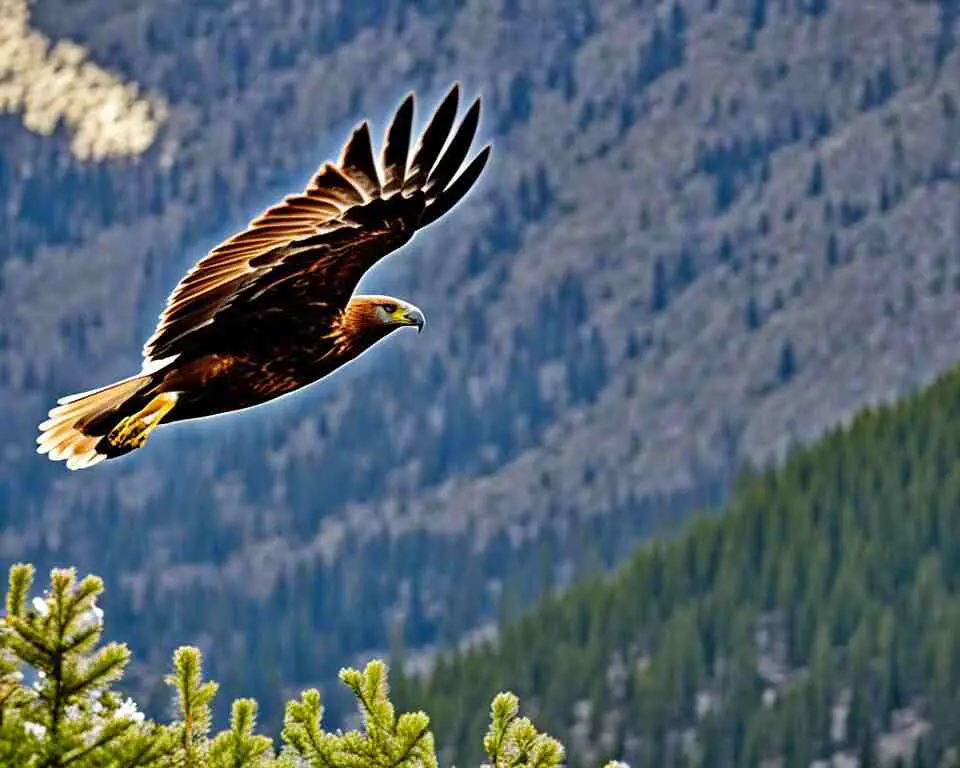
Eternal Bonds: Mates for Life, the Love Story of Eagles
Eagles, known for their majestic presence, display remarkable fidelity in their relationships, as they are monogamous creatures that frequently choose lifelong partners, showcasing the strength and commitment of their bonds.
Eyries: Engineering Marvels of Eagles’ Nesting Habitats
These remarkable creatures construct massive eyries, magnificent structures meticulously crafted in lofty treetops or perched precariously upon towering cliffs, serving as secure havens for their young and offering breathtaking panoramic views of their surroundings.
The Not-So-Bald Eagle: Unveiling the White-Crowned Symbol
The bald eagle, the national bird and symbol of the United States, is not actually bald. It has white feathers on its head, which gave it the name “bald” in the old English sense, meaning white.
Aerial Romance: Eagle Courtship, Where Dives Become Art
Eagles captivate with their distinctive courtship display, showcasing breathtaking aerial acrobatics. Astonishing dives and mesmerizing cartwheels grace the sky, making it a truly awe-inspiring spectacle that sets them apart in the avian world.
Eagles: Versatile Hunters of Land and Sky
Eagles possess a diverse culinary preference, relying mainly on a menu comprising fish, small mammals, birds, and reptiles to satiate their appetite and sustain their majestic existence in the natural realm.
Eagle Scavengers: Opportunistic Food Thieves
Certain eagle species exhibit opportunistic feeding behaviors, showcasing their ability to scavenge and pilfer sustenance from diverse avian or animal sources, exemplifying their resourcefulness and adaptability in acquiring nourishment.
Harpy Eagle: Rainforest’s Mighty Giant
The magnificent harpy eagle, inhabiting the lush rainforests of Central and South America, commands awe as it soars the skies. Renowned for its immense size and strength, it reigns supreme among the planet’s mightiest avian predators.
Eagles’ Mighty Talons: Overcoming Prey Weight
Eagles possess incredibly formidable talons, capable of exerting immense force. This remarkable attribute empowers them to skillfully capture and transport prey that far surpasses their own weight, showcasing their exceptional hunting prowess.
Locking Talons: Eagles’ Mid-Flight Capture Skill
These birds possess an astonishing talent for securing their talons firmly, enabling them to seize and grasp their prey with unwavering precision even during soaring pursuits through the air.
Silent Hunters: Eagles’ Stealthy Feather Design
Eagles possess a remarkable feather configuration that grants them the extraordinary ability of noiseless flight. This silent prowess enhances their hunting skills, making them highly efficient predators in the avian realm.

Molting Eagles: Regeneration Through Feather Shedding
Each year, these birds experience a remarkable molting process, where they gracefully shed their feathers and grow new ones. This cyclic renewal ensures their feathers remain in optimal condition, enabling them to soar through the skies with elegance and efficiency.
Eagles in Mythology: Revered and Symbolic Figures
Throughout history, eagles have been revered and celebrated in diverse cultures and mythologies. These majestic birds symbolize strength, freedom, and power, serving as powerful emblems of courage and transcendence across the world.
Eagles in Native American Culture: Strength and Wisdom
Eagles hold sacred significance and embody strength, courage, and wisdom in certain Native American cultures. Revered as powerful symbols, they epitomize the profound qualities that inspire and uplift, connecting humanity with the essence of nature’s majesty.
Philippine Eagle: Rarest and Endangered Eagle Species
The Philippine eagle, scientifically known as Pithecophaga jefferyi, is a highly endangered species with a minuscule population. It holds the title of being one of the rarest and most critically endangered eagle species globally, earning the alternative name “monkey-eating eagle.”
Ecological Role of Eagles: Balancing Prey Populations
Eagles are crucial for ecological balance, as they regulate prey populations. Through their predation, these majestic birds help prevent overpopulation, ensuring a harmonious coexistence among species and preserving the delicate equilibrium of ecosystems.
Territorial Behavior: Eagles Defend Nesting Sites
Certain species of eagles exhibit territorial behavior and fiercely protect their nesting sites, demonstrating their aggressive nature. These majestic birds command respect due to their remarkable territorial instincts and unwavering commitment to safeguarding their offspring.
Eagles’ Color Vision: Spotting Prey in Challenging Lighting
Eagles possess remarkable color vision, granting them the ability to effortlessly discern prey amidst difficult lighting conditions. Their exceptional visual acuity empowers them to navigate their surroundings and spot potential meals with unmatched precision and efficiency.
Martial Eagle: Sub-Saharan Africa’s Powerhouse
The martial eagle, a magnificent species native to sub-Saharan Africa, stands out as a formidable predator. With its impressive size and strength, it holds the distinction of being one of the continent’s largest and most commanding birds of prey.
Unique Respiratory System: Efficient Oxygen Intake in Flight
The Eagles possess an extraordinary respiratory system, specifically adapted for efficient oxygen uptake during their remarkable flights through the skies, setting them apart from other avian species.
Wingspan Variation: Eagles’ Impressive Size Range
Eagles exhibit a wingspan that spans between 5 and 8 feet (equivalent to 1.5 to 2.4 meters), showcasing remarkable variation in size, a factor largely influenced by the specific species of these majestic birds of prey.
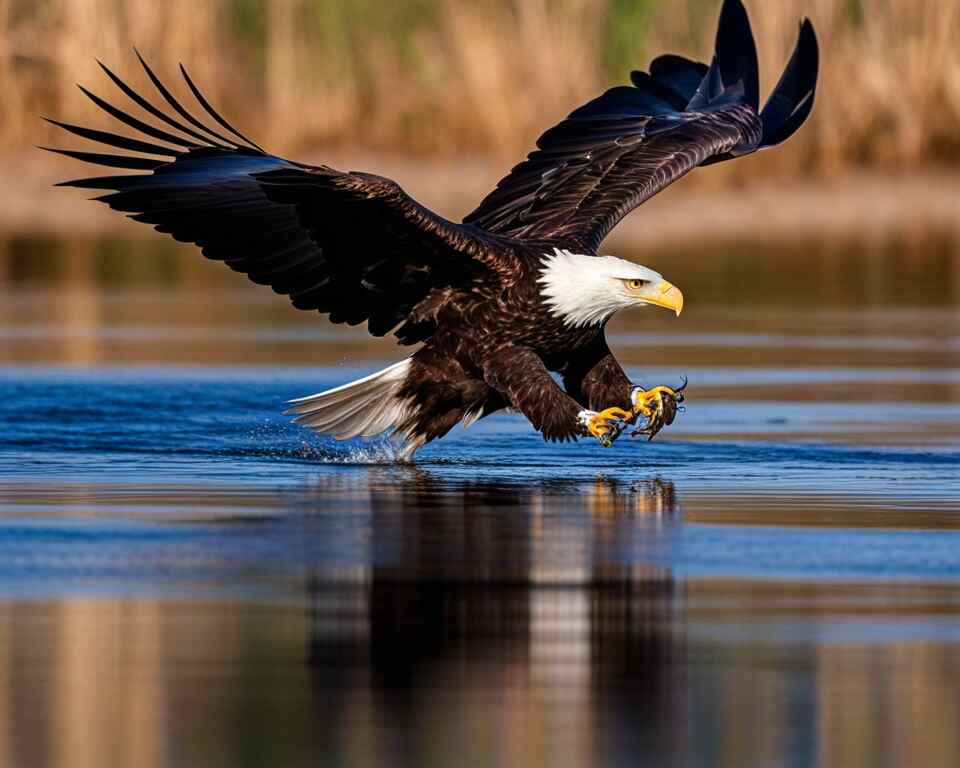
Eagles in Falconry: Centuries of Hunting Partnership
For centuries, eagles have been meticulously trained for falconry—a captivating hunting sport. The artful practice involves the harmonious partnership between humans and these majestic birds, showcasing the rich history and tradition woven into the fabric of our civilization.
Golden Eagle in Ancient Rome: Symbol of Power and Authority
In ancient Rome, the majestic golden eagle symbolized the divine might of Jupiter, the revered Roman god. This revered avian emblem embodied the very essence of supremacy and dominion, serving as an emblematic representation of power and authority.
African Fish Eagle’s Distinct Call: Echoes of the African Wilderness
The African fish eagle, renowned for its majestic presence, possesses a remarkable vocalization that resonates through the vast expanse of the African wilderness. Its distinctive call captivates the hearts of nature enthusiasts, symbolizing the untamed beauty and rich biodiversity of the continent.
Scientific Studies: Insights into Eagle Behavior and Conservation
Scientists and researchers have devoted considerable effort to studying eagles, delving into their behavior, ecology, and conservation requirements. These comprehensive investigations aim to enhance our comprehension of these magnificent birds and address their crucial preservation demands.
Crowned Eagle: Impressive Strength and Large Prey Capture
The crowned eagle, native to sub-Saharan Africa, exhibits remarkable power and skill in hunting, as it effortlessly captures and eliminates sizeable prey. Its reputation is founded on its awe-inspiring strength and formidable hunting prowess.
Soaring Masters: Eagles’ Skillful Use of Updrafts and Thermals
Eagles possess an extraordinary talent, effortlessly soaring and gliding through the skies for prolonged durations. They skillfully leverage updrafts and thermals to their advantage, conserving precious energy while showcasing their unparalleled aerial prowess.
White-Tailed Eagle: Europe’s Magnificent Sea Eagle
The white-tailed eagle, scientifically known as Haliaeetus albicilla and commonly referred to as the sea eagle, is a magnificent avian species inhabiting Europe. Renowned for its impressive size, it stands as one of the continent’s most majestic and formidable birds of prey.
Hierarchical Social Structure: Dominance in Eagle Territories
The eagle’s social structure is characterized by a hierarchical system where dominant individuals establish their authority, exerting control and dominance over fellow members within their territorial domain.
Epic Migrations: Eagles on Long-Distance Journeys
Certain eagle species, like the majestic bald eagle, embark on awe-inspiring migrations, traversing vast distances in search of optimal habitats for breeding and nourishment. These remarkable journeys showcase their adaptability and determination to secure ideal conditions for their survival.
Harpy Eagle: Mighty Claws of Power
The harpy eagle is known for its remarkably robust claws, measuring an astonishing 5 inches (13 centimeters) long. These massive and formidable talons contribute to its predatory prowess and make it a force to be reckoned with in the avian world.
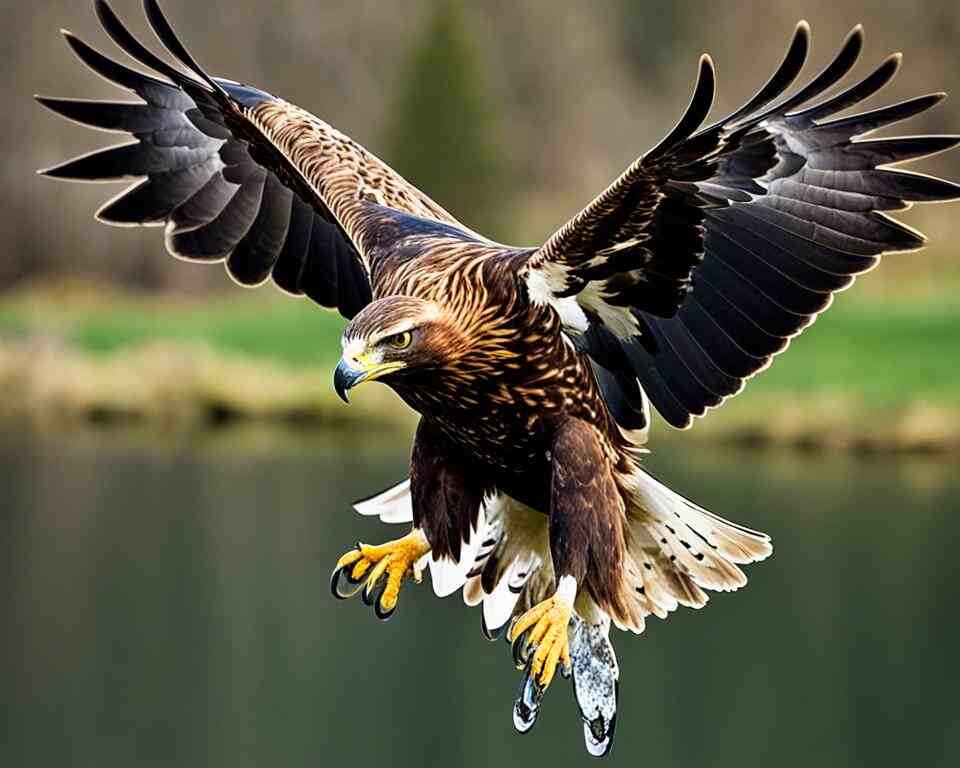
Keen Hearers: Eagles’ Hidden Prey Detection
Eagles possess remarkable auditory acuity, enabling them to perceive potential quarry, even if concealed or blending seamlessly with their surroundings, due to their exceptional hearing capabilities.
Indian Spotted Eagle: Distinctive Plumage Marvel
The Indian spotted eagle, a medium-sized eagle endemic to South Asia, is celebrated for its unique plumage pattern that sets it apart. Its presence graces the skies of the region, making it a remarkable sight to behold.
Emblematic Eagles: Coins, Stamps, Flags, and More
Eagles, majestic creatures, have adorned coins, stamps, flags, and coats of arms in numerous nations globally. Their regal presence symbolizes power, freedom, and national pride, making them a ubiquitous emblem of strength and resilience across cultures.
Lifespan Extremes: Eagle Longevity Variances
Eagles, majestic birds of prey, exhibit lifespans varying between 20 and 50 years. Their longevity hinges on species type and influential environmental elements that shape their existence and determine their time on Earth.
Majestic Wedge-Tailed Eagle: Wingspan Wonder
The wedge-tailed eagle, a magnificent avian species endemic to Australia, boasts an impressive wingspan of up to 9 feet (2.8 meters), solidifying its status as one of the globe’s largest and most formidable raptors.
Conservation Focus: Protecting Eagle Habitats
Over the years, eagles have become a focal point for extensive conservation initiatives, aiming to safeguard their natural environments and guarantee their long-term existence through dedicated efforts and proactive measures.
Steppe Eagle’s Long-Distance Ventures
The steppe eagle, a remarkable bird species inhabiting regions across Europe and Asia, captivates with its awe-inspiring ability to undertake extensive migrations, traversing vast distances in its quest for survival and sustenance.
Aerial Confrontations: Eagles Defending their Domain
Eagles display remarkable aerial prowess as they fiercely engage in territorial or food disputes, fearlessly challenging formidable opponents like hawks and vultures, engaging in awe-inspiring battles high above the ground.
The black eagle, native to Africa and Asia, is renowned for its remarkable agility and adeptness in navigating through dense woodland environments, showcasing its unparalleled skills and adaptability within its natural habitat.
Cultural Icons: Eagles’ Symbolic Significance
Eagles, magnificent creatures of the sky, have long been revered in diverse artistic expressions, literature, and folklore. Symbolizing freedom, strength, and grandeur, they capture the human imagination with their awe-inspiring presence and enduring symbolism.
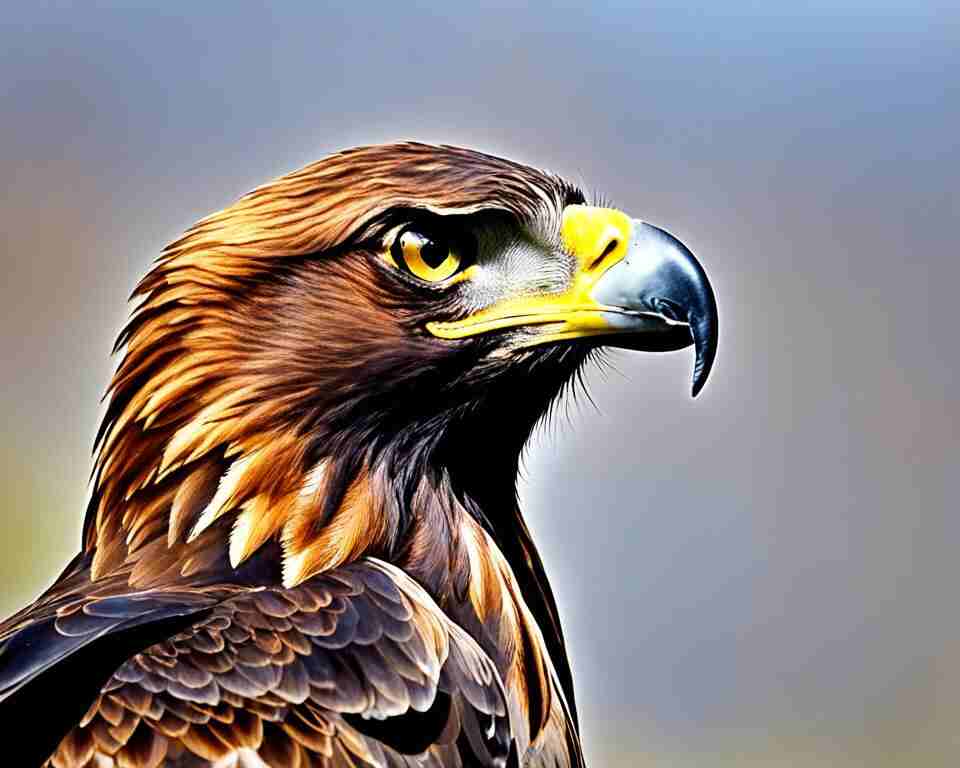
Striking Sea Eagle: Coastal Hunting Expert
The white-bellied sea eagle, a magnificent bird of prey, inhabits the stunning coastal areas of Australia and Southeast Asia. Renowned for its remarkable beauty and impressive hunting abilities, it captivates observers with its striking appearance and remarkable prowess.
Nutrient Extraction: Eagles’ advanced digestive systems
Eagles possess remarkably advanced digestive systems, enabling them to efficiently extract optimal nourishment from the prey they consume, thereby maximizing their nutrient intake for sustenance and energy acquisition.
Bateleur Eagle: Acrobatic flyer with short tail
The bateleur eagle, a captivating species native to Africa, captures attention with its remarkable aerial maneuvers and unique physical traits, such as its conspicuous short tail. Its acrobatic flight displays are truly mesmerizing to behold.
Protective Membrane: Eagles’ nictitating eyelid
Eagles, magnificent birds of prey, possess a remarkable adaptation known as a nictitating membrane. This specialized third eyelid serves as a shield, safeguarding their eyes from potential harm while they soar through the skies and engage in their skilled hunting endeavors.
Speedy Golden Eagle: Flying up to 150 mph
The golden eagle, a remarkable bird of prey, soars through the skies with astonishing speed. In level flight, it can achieve incredible velocities, clocking in at a staggering 150 miles per hour (240 kilometers per hour).
Tracking Eagles: GPS monitoring and migration
Researchers have utilized advanced tracking technologies like GPS and satellite transmitters to study eagles, monitoring their migration patterns and movements. These studies provide valuable insights into the behavior and ecology of these majestic birds of prey.
Versatile Tawny Eagle: Hunting and scavenging skills
The tawny eagle, a prominent bird of prey in Africa and parts of Asia, is recognized for its exceptional hunting and scavenging abilities. Its versatility in feeding habits enables it to thrive in diverse habitats and environments.
Symbolic Meaning: Eagles represent wisdom and spirituality
Eagles have held significant spiritual and symbolic meanings across many cultures, symbolizing wisdom, vision, and spiritual connection. Their powerful presence and soaring flight have been revered as a representation of strength, freedom, and divine guidance, inspiring awe and admiration.
Snake Specialist: Short-toed Snake Eagle’s prey preference
The short-toed snake eagle, a bird of prey found in Europe, Asia, and Africa, is a specialized hunter of reptiles, with a particular focus on snakes. Its unique hunting skills and feeding habits make it a fascinating species for researchers and bird enthusiasts alike.
Threats to Eagles: Habitat loss, pollution, hunting, power lines
Eagles have been subjected to numerous threats, including habitat destruction, pollution, illegal hunting, and electrocution from power lines. These factors have significantly impacted their numbers, leading to the decline of many eagle populations worldwide. Conservation efforts are crucial to protect these majestic birds and their habitats.
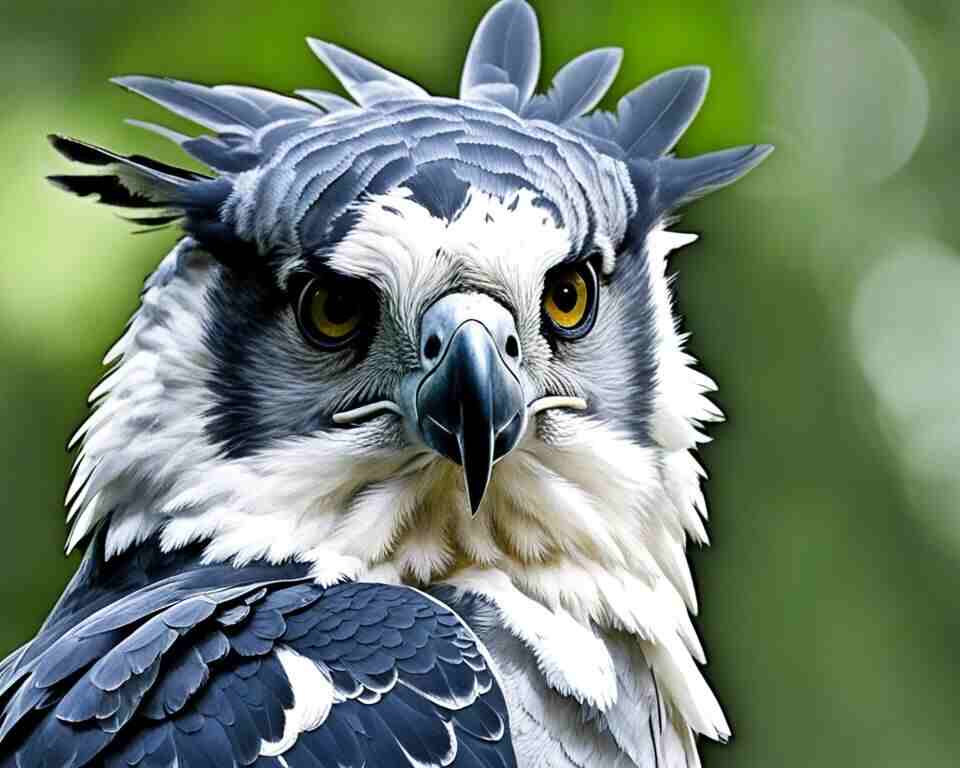
The African crowned eagle is renowned for its distinct hunting strategy, which involves launching surprise attacks on prey from a concealed perch. This bird of prey, found in the forests of Sub-Saharan Africa, is known for its strength and agility, making it a formidable predator in its habitat.
Symbolic Strength: Eagles inspire sports, organizations, military
Eagles have been adopted as symbols by various sports teams, organizations, and military units due to their unwavering strength and determination. Their powerful presence and soaring flight have been seen as an inspiration for athletes, soldiers, and leaders alike, representing excellence, courage, and victory.
Exceptional Agility of Some Eagle Species
Certain eagle species, like the African hawk-eagle, are renowned for their exceptional agility and adeptness in navigating through dense forests. Their sharp talons and powerful wings enable them to maneuver swiftly and precisely, making them formidable hunters in their habitat.
The African Pygmy Eagle – One of the Smallest Eagle Species
The African pygmy eagle is a diminutive eagle species, measuring only about 14 inches (35 centimeters) in length, making it one of the smallest eagle species. Despite its small size, it is a skilled hunter and an important predator in its habitat, preying on small mammals, birds, and reptiles.
Eagles’ Unique Feather Control for Flight Stability
Eagles possess a unique ability to adjust the position of their feathers during flight, allowing them to control airflow and maintain stability. This adaptation is crucial for their hunting and survival, enabling them to soar through the air with precision and efficiency, even in turbulent conditions.
The African Booted Eagle – Named for its Feathered “Boots
The African booted eagle is named for its unique feathered appearance, with feathers on its legs that resemble boots or leggings. This distinctive feature sets it apart from other eagle species and makes it easily recognizable. The African booted eagle is found in various habitats across Africa and is known for its hunting prowess and agility.
Eagles’ Spectacular Courtship Displays
Eagles have been observed engaging in breathtaking courtship displays, which involve mid-air talon-locking, somersaults, and other acrobatic feats. These elaborate displays are essential for pair bonding and mate selection, and they provide a stunning spectacle for observers. The courtship displays vary among eagle species, with some being more elaborate and intricate than others.
The Martial Eagle’s Powerful Grip
The martial eagle, a large African bird of prey, is renowned for its exceptionally strong grip, capable of exerting pressures of over 200 pounds (90 kilograms) per square inch. This powerful grip enables the martial eagle to capture and subdue large prey, including antelopes and small monkeys, making it one of the most formidable predators in its habitat.
Eagle Species with a Preference for Hunting Snakes
Certain eagle species, such as the crowned solitary eagle, have a particular preference for hunting large snakes as their primary prey. These eagles have adapted to specialize in hunting snakes, which can be challenging prey due to their size and agility. The crowned solitary eagle is found in South America and is considered one of the rarest and most elusive eagle species in the world.
Eagles’ Sharp, Hooked Beaks for Tearing Prey
Eagles possess a sharp, hooked beak that is perfectly adapted for ripping and tearing apart their prey into manageable pieces. This powerful beak is an essential tool for hunting and survival, enabling eagles to consume a wide range of prey, including fish, small mammals, and birds. The beak is also used for other tasks, such as preening feathers and constructing nests.

The White-Bellied Sea Eagle’s Exceptional Fishing Skills
The white-bellied sea eagle is a skilled hunter, snatching fish from the water’s surface with its sharp talons and keen eyesight. This bird is found in coastal regions of Australia and Southeast Asia, and is one of the largest birds of prey in the world, playing a significant role in its ecosystem.
The African Fish Eagle – “Voice of Africa”
The African fish eagle is known as the “Voice of Africa” due to its distinctive and melodious call, consisting of high-pitched whistles and trills. This bird of prey is found throughout sub-Saharan Africa and is an important part of African culture and folklore.
Eagles’ Spectacular Territorial Displays
Eagles engage in spectacular territorial displays, including high-altitude chases and dramatic vocalizations, to establish and maintain their territories and warn other eagles to stay away. These displays vary among species.
The Golden Eagle – One of the Most Studied Eagle Species
The golden eagle, with its broad range and iconic status, has been studied extensively, generating valuable insights into its behavior, ecological roles and relationships, conservation needs, and socioeconomic impacts on communities. Researchers continue to study this species to better understand and protect it.
Eagles’ Sharp, Curved Talons for Secure Prey Holding
Eagles are renowned for their sharp, curved talons, which they use to capture and hold onto prey securely. The talons are one of the bird’s most important tools, allowing it to catch and subdue prey quickly and efficiently.
The Martial Eagle’s Impressive Wingspan and Weight
The martial eagle (Polemaetus bellicosus) boasts an impressive wingspan of up to 6.6 feet (2 meters) and can weigh up to 14 pounds (6.3 kilograms). This powerful bird of prey is one of Africa’s largest eagles, known for its strength and hunting prowess.
Eagles’ Aggressive Aerial Pursuits for Food
Eagles, including bald eagles and others, are occasionally known to steal food from other birds, such as ospreys or vultures, through aggressive aerial pursuits. These behaviors can occur during periods of food scarcity or as a way to assert dominance over other birds.
The African Hawk-Eagle’s Unique Hunting Technique
The African hawk-eagle (Aquila spilogaster) is recognized for its distinctive hunting style, known as “stooping,” where the bird rapidly descends from the sky and attacks its prey. This technique is a testament to the bird’s agility, strength, and voracious appetite.
Eagles as Symbols of Power and Protection
Throughout history, eagles have been revered in many cultures as symbols of power and protection. From Ancient Egypt and Greece to modern-day government seals, these majestic birds have been seen as representations of courage, loyalty, and freedom for centuries.
The Golden Eagle’s Adaptability to Diverse Habitats
The versatile golden eagle (Aquila chrysaetos) is an adaptable bird of prey that can thrive in various habitats, ranging from rugged mountains to vast deserts and sprawling grasslands. Their impressive adaptability is a testament to their strength and resilience as a species.

Eagles’ Playful Activities to Strengthen Social Bonds
Eagles, such as the bald eagle, have been observed engaging in playful behaviors, such as mock fighting or swooping flights, that could potentially strengthen social bonds. These playful activities may be a way for eagles to practice hunting skills or establish social hierarchies vital to their survival in the wild.
The Harpy Eagle’s Exceptionally Large and Sharp Talons
The harpy eagle boasts impressively long and razor-sharp talons, reaching an extraordinary size of 3-4 inches (8-10 centimeters) in length, making them formidable and efficient predators in their natural habitat.
The African Hawk-Eagle’s Distinctive Call
The African hawk-eagle captivates with its unique call, resembling a melodious high-pitched whistle, echoing through the skies. This remarkable bird enchants with its repetitive and unmistakable vocalization, leaving an indelible mark on the African wilderness.
Eagles’ Respiratory System Adaptations for High Altitude Efficiency
Eagles possess remarkable respiratory adaptations, enabling efficient oxygen extraction in high-altitude environments. These specialized features grant them the advantage of soaring effortlessly through thin air, solidifying their status as masters of the sky.
The Black-Chested Buzzard-Eagle – Striking Plumage and Fierce Hunting Skills
The black-chested buzzard-eagle, a magnificent raptor endemic to South America, captivates with its stunning plumage and formidable prowess in hunting. Its distinct appearance and unparalleled hunting abilities make it an awe-inspiring species in the avian realm.
Eagles’ Soaring Abilities without Flapping Wings
The majestic Eagles possess an extraordinary skill, effortlessly gliding through the sky for extended periods, devoid of wing flaps. They gracefully harness thermals and updrafts, ingeniously employing these forces to sustain their lofty elevation for hours on end.
The Crested Serpent Eagle’s Distinctive Crown of Feathers
The crested serpent eagle, a majestic bird native to Southeast Asia, possesses a remarkable appearance with its crown of feathers adorning its head, reminiscent of an elegant and regal headdress, adding to its allure and charm.
Eagles’ Acute Sense of Balance for Precise Perching
Eagles possess exceptional balance, allowing them to effortlessly navigate delicate perches on slender branches or rugged cliffs, showcasing their remarkable precision and adaptability in various environments.
The Philippine Eagle’s Enormous Bill for Tearing Tough Prey Hides
The remarkable Philippine eagle is famed for its massive bill, specialized in effortlessly rending the resilient hides of monkeys and diverse prey, showcasing its exceptional predatory prowess and contributing to its well-deserved status as an awe-inspiring apex predator.
Eagles’ Massive Nests Weighing up to 2,000 Pounds
Eagles are renowned for their colossal nests, reaching staggering weights of 2,000 pounds (900 kilograms). These impressive structures are meticulously crafted over the course of several years, showcasing the remarkable dedication and engineering prowess of these majestic birds.

Eagles’ Depiction in Ancient Art and Hieroglyphics
Eagles, majestic creatures, have been revered since ancient times, their regal presence immortalized in art and hieroglyphics. They embody both divine protection, guarding realms, and profound spiritual symbolism, inspiring awe and reverence across civilizations.
Eagles’ Food Stealing from Other Predators
Eagles, cunning in their pursuit of sustenance, seize chances to pilfer meals from fellow hunters. They audaciously snatch morsels from the jaws of foxes or the startled gaze of hyenas, establishing their dominance with aerial finesse.
The Crested Eagle – Unique Crested Appearance and Strong Hunting Skills
The crested eagle, native to Central and South America, boasts a striking crested visage, showcasing its distinctive allure. Furthermore, this magnificent raptor exhibits exceptional prowess in hunting, making it a formidable predator in its natural habitat.
Eagles’ Thermoregulation for Body Temperature Maintenance
Eagles possess an exceptional thermoregulatory prowess, enabling them to effortlessly regulate their body temperature in the face of harsh climates, be it bone-chilling cold or scorching heat. Their remarkable adaptation ensures their survival in extreme environmental conditions.
The African Hawk-Eagle’s Nest Shade Creation
The remarkable African hawk-eagle employs its majestic wings to ingeniously shield its nest, ensuring protection against scorching temperatures by skillfully generating a comforting shade. This adaptation showcases the species’ remarkable ingenuity in adapting to its environment.
Eagles’ Highly Developed Sense of Spatial Awareness
Eagles, magnificent birds of prey, possess remarkable spatial awareness, a trait that empowers them to skillfully traverse intricate landscapes and conquer challenging environments with precision and grace, showcasing their unparalleled navigational abilities.
The Short-Toed Snake Eagle – Impressive Mid-Air Snake Captures
The short-toed snake eagle is a specialized raptor adept at hunting snakes. Its aerial prowess is remarkable, as it has been documented showcasing impressive mid-air snake captures, displaying its exceptional hunting skills with finesse.
Eagles as Symbols in Mythology, Folklore, and Religion
Eagles have long held significant roles in mythologies, folklore, and religious beliefs, serving as powerful symbols representing wisdom, far-sightedness, and even the intervention of divine forces in human affairs.
White-Bellied Sea Eagle’s Nest Shade Creation
The white-bellied sea eagle showcases remarkable ingenuity by utilizing sticks or branches to construct a cleverly improvised canopy for its nest. This ingenious behavior offers essential shelter, shielding the nest from harsh elements and ensuring the safety of its inhabitants.
Eagles as Mascots for Sports Teams and Organizations
Eagles, revered for their remarkable attributes of strength, agility, and competitiveness, have long served as cherished mascots for sports teams and organizations, embodying the indomitable spirit that fuels victory and inspiring awe in fans worldwide.
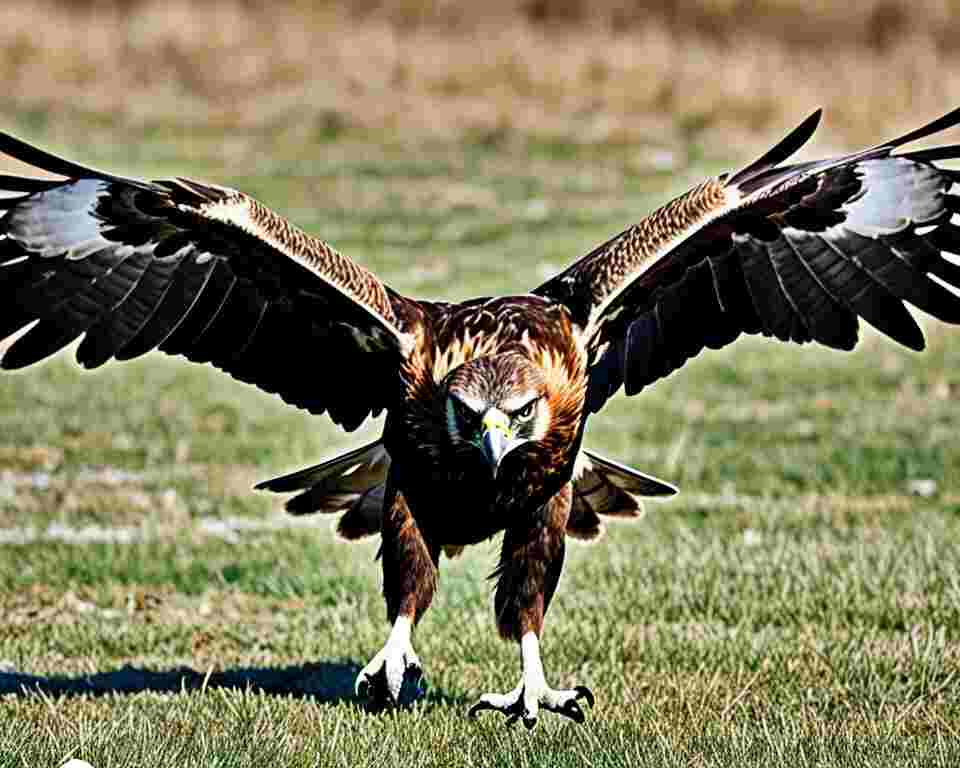
The Crested Serpent Eagle’s Distinctive “Eyebrows”
The crested serpent eagle boasts captivating “eyebrows,” comprising elongated feathers above its eyes. These unique features elevate its facial expression, making it a visually striking bird of prey.
Eagles’ Uropygial Gland for Feather Preening and Waterproofing
Eagles possess a remarkable adaptation in the form of the uropygial gland, positioned near their tail. This gland efficiently produces oil that serves the dual purpose of feather maintenance, through preening, and protecting against water by enhancing waterproofing capabilities.
The Philippine Eagle’s Critical Endangerment and Conservation Efforts
The Philippine eagle, an endangered species, faces a critical situation with a mere 400 pairs surviving in their natural habitat. Consequently, conservation initiatives become pivotal in securing the future existence of this majestic bird.
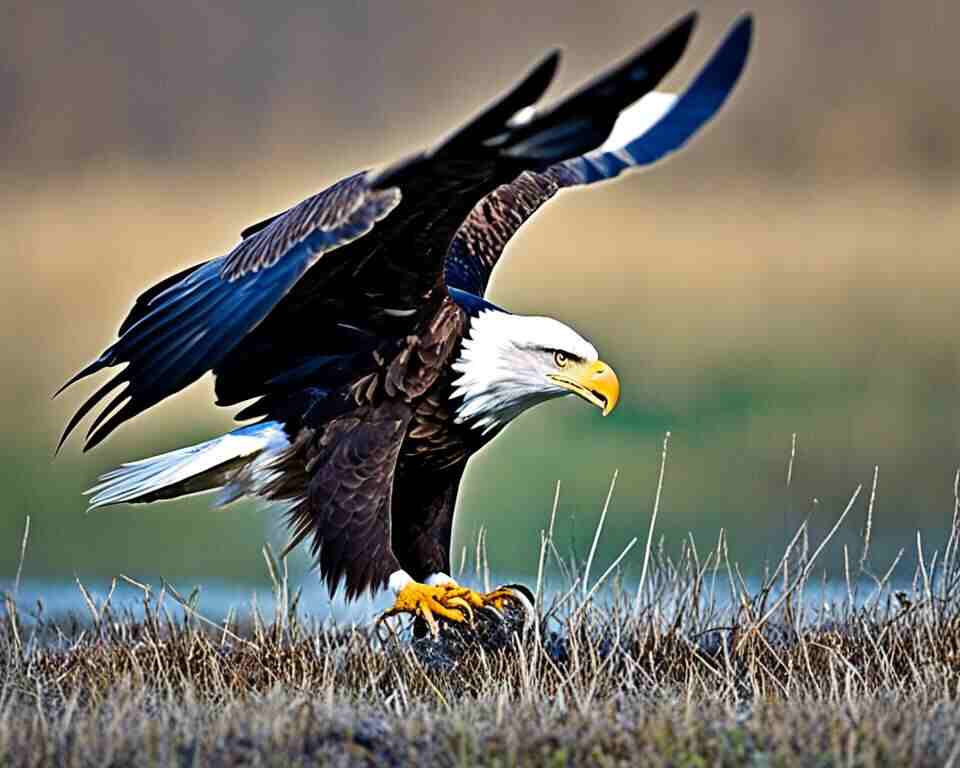
Common Eagle Species Facts
| Eagle Species | Scientific Name | Habitat | Size | Diet | Lifespan |
|---|---|---|---|---|---|
| Bald Eagle | Haliaeetus leucocephalus | North America | 28-40 inches (71-101 cm) tall, 6-14 lbs (2.7-6.4 kg) weight, 6.5-7.5 ft (2-2.3 m) wingspan | Fish, waterfowl, small mammals, carrion | 20-30 years |
| Golden Eagle | Aquila chrysaetos | North America, Europe, Asia | 27-33 inches (69-84 cm) tall, 6.5-15 lbs (3-7 kg) weight, 6-7.5 ft (1.8-2.3 m) wingspan | Rabbits, hares, rodents, reptiles, birds, carrion | Up to 32 years |
| Harpy Eagle | Harpia harpyja | Central and South America | 35-41 inches (89-104 cm) tall, 9-20 lbs (4-9 kg) weight, 6.5-7.5 ft (2-2.3 m) wingspan | Monkeys, sloths, other mammals, birds | Up to 25 years |
| African Fish Eagle | Haliaeetus vocifer | Africa | 27-31 inches (68-78 cm) tall, 4-7 lbs (1.8-3.2 kg) weight, 6-8 ft (1.8-2.4 m) wingspan | Fish, waterbirds | 20-30 years |
| Steller’s Sea Eagle | Haliaeetus pelagicus | Russia, Japan, Korea | 36-40 inches (91-102 cm) tall, 15-20 lbs (6.8-9.1 kg) weight, 7-8 ft (2.1-2.4 m) wingspan | Fish, waterbirds, small mammals, carrion | Up to 30 years |
| White-tailed Eagle | Haliaeetus albicilla | Europe, Asia | 28-37 inches (71-94 cm) tall, 6-15 lbs (2.7-6.8 kg) weight, 7-8 ft (2.1-2.4 m) wingspan | Fish, waterbirds, carrion | Up to 25 years |
| Martial Eagle | Polemaetus bellicosus | Africa | 32-39 inches (81-99 cm) tall, 6-14 lbs (2.7-6.4 kg) weight, 6.5-8 ft (2-2.4 m) wingspan | Small mammals, birds, reptiles | Up to 20 years |
Note: The eagles listed in the table are some of the most common species of eagles found around the world. However, there are many other species of eagles that are not included in the table.
Conclusion
In conclusion, eagles are truly remarkable creatures with a fascinating array of characteristics and behaviors. From their impressive wingspan to their acute eyesight, eagles have evolved to be highly specialized hunters and survivors in their respective habitats.
Learning about these magnificent birds not only deepens our appreciation for the natural world, but also reminds us of the importance of protecting and preserving these magnificent creatures for future generations to enjoy.
As we continue to study and admire eagles, let us also do our part to ensure that they can continue to soar through the skies and thrive in their ecosystems for years to come.
FAQs:
What is the lifespan of an eagle?
The lifespan of an eagle varies by species, but generally ranges from 20 to 30 years. Some eagles, such as the bald eagle, can live up to 40 years in the wild. Eagles in captivity can live even longer, with some living up to 50 years.
Do all eagles mate for life?
While some eagle species, such as bald eagles, are known for forming long-term mating pairs, not all eagles mate for life. Some eagle species, such as the golden eagle, form pairs for one breeding season, while others, such as the harpy eagle, are known to form pairs for multiple breeding seasons.
What is the wingspan of an eagle?
The wingspan of an eagle varies by species, but generally ranges from 5 to 8 feet. The largest eagle species, the Steller’s sea eagle, has a wingspan of up to 9 feet.
How fast can an eagle fly?
Eagles can fly at varying speeds, but generally range from 20 to 50 miles per hour while cruising. When diving for prey, eagles can reach speeds of up to 200 miles per hour.
What do eagles eat?
Eagles are carnivores and primarily eat fish, small mammals, and birds. Some eagle species, such as the golden eagle, have been known to take down larger prey such as deer or antelope.
Where do eagles live?
Eagles are distributed across all continents of the world except for Antarctica. They typically live in open habitats such as mountains, forests, and wetlands.
How do eagles hunt?
Eagles use their sharp eyesight to locate prey from high in the sky. They then dive at high speeds to catch their prey with their sharp talons.
Are eagles endangered?
Some eagle species, such as the Philippine eagle and the harpy eagle, are considered endangered due to habitat loss and hunting. However, many eagle species, such as the bald eagle, have made a recovery due to conservation efforts.
Can eagles swim?
While eagles are not adapted for swimming, they are able to swim short distances if necessary. However, they are primarily aerial hunters and fishers.
Do eagles migrate?
Many eagle species are migratory and will travel long distances to breed or to find food during the winter months. Bald eagles, for example, are known to migrate to areas with open water in the winter.
How many eagle species are there?
There are over 60 species of eagles found throughout the world, with the largest concentration in Africa and Asia.
What is the biggest eagle?
The Steller’s sea eagle is the largest eagle species, with males weighing up to 20 pounds and a wingspan of up to 9 feet.
Are eagles social animals? Answer: Eagles are typically solitary animals, but some species, such as the African fish eagle, are known to live in small family groups.
Can eagles be trained?
Eagles can be trained for falconry and other hunting practices, but it requires extensive training and specialized knowledge to do so safely and ethically.
Do eagles cry or screech?
Eagles do not cry in the way that humans do. However, they do make a variety of sounds, including screeching, chirping, and whistling. These sounds can be used for a range of purposes, such as to communicate with other eagles, warn of danger, or claim territory.
How do you distinguish an eagle from a vulture?
Eagles and vultures are both large birds of prey, but there are some key differences in their appearance. Eagles have a hooked beak, strong legs and talons, and broad, flat wings, while vultures have a bald head, weak legs and talons, and a narrow, V-shaped wingspan.
What is the significance of eagles in different cultures?
Eagles have been revered in many cultures throughout history as symbols of strength, freedom, and power. In Native American culture, eagles are seen as spiritual messengers and are often depicted in art and ceremony.
When was the bald eagle chosen as the symbol of America?
The bald eagle was chosen as the national symbol of the United States in 1782 because of its majestic appearance and strength, as well as its association with freedom and independence.
Are male and female eagles the same size?
No, in most species of eagles, females are larger than males. This is known as sexual dimorphism and is thought to be an adaptation to allow females to better protect and care for their young.
Related Post:


